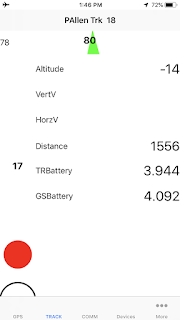The M1101 flight in the Competitor went off perfectly on Saturday (6/22/19). It was an impressive launch, reaching 13,400 feet and 880 mph (Mach 1.14). Both of these figures shattered my previous records. Thanks to Clare, Sean, and Bob for supporting this flight!
Some interesting points/notes:
- The performance shattered expectations, which were based on Rocksim simulations, which I have dialed in well for subsonic flights. I had to change the Cd from .56 to .44 to achieve an accurate performance prediction for this flight. (I believe using my Cd override value from the previous 5 subsonic flights also overrode the software's calculation of supersonic flights. When I let Rocksim calculate the drag for the simulations, it was fairly accurate for the single supersonic flight, and less accurate for the subsonic flights.)
- The rotation nearly stops while the rocket was supersonic. It clearly points to the difference in subsonic vs. supersonic aerodynamics.
- The rocket was above Mach 1 for about 3 seconds (from 3.5 to 6.5 seconds)
- 13,400 feet was high enough where the usual 1.25 gram drogue charge was noticeably weaker than at 6,000 feet
- The rocket was nearly a mile upwind at apogee.
- No one saw the rocket at all after motor burnout until the main fired over 3 minutes later.
- The new swivel from Onebadhawk Rocketry seems to have helped to reduce the drogue shock cord from spinning up.
- The 4" x 40" streamer seemed to work well for a drogue. Descent rate was 75 feet per second.
- The main descent rate was about 25 feet per second.
It was quite breezy so the angle at the launch pad was critical for landing in the field. Fortunately, we got it right and it landed just 1500 feet away. Unfortunately, the wind dragged the rocket a long way through the muck field and made a small crack in the forward end of the booster tube.
 |
| Motor Built, Ready for Final Assembly |
 |
Ready for the "BFR" Safety Inspection.
(The nose cone is not in place so that I could arm the GPS at the pad and conserve battery.) |
 |
| Ready for Launch |
 |
| A Pic with Sean (Thanks for the help!) |
 |
The Perfectflite SL100 Data.
Note the non-smooth nature of the ascent curve. This is due to rapid pressure changes during the Mach transitions. |
 |
| A Screen Capture of the GPS Tracking at Landing |
 |
| Trail from Getting Dragged |
 |
Nose Cone Landing
(Note the rest of the recovery team at the edge of the brown part of the field.) |









No comments:
Post a Comment